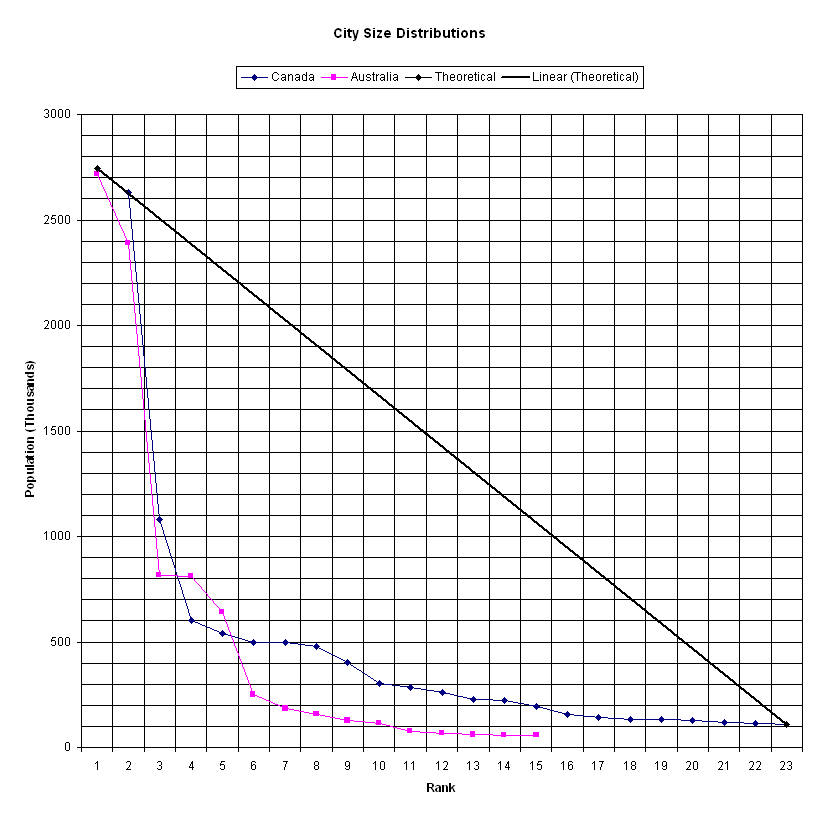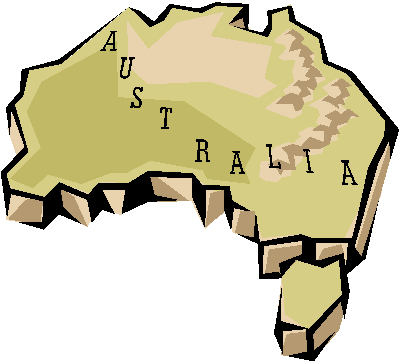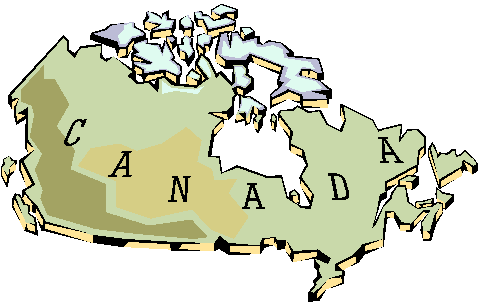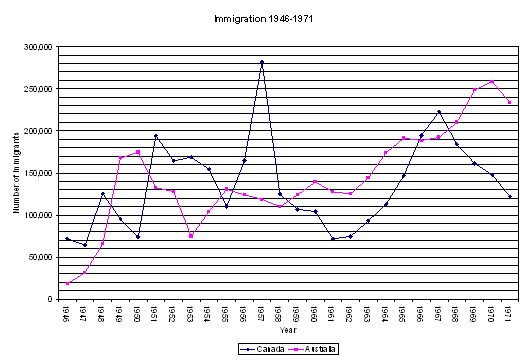
Figure 4 - City Size Distributions, 1971
The Major Similarities and Differences Between the Development of Canadian and Australian Urban Systems During the Period 1841-1971
The analysis of the Canadian and Australian Urban systems is intriguing because both have similar histories and have reached very similar patterns in their urban systems, using different methods.
A number of factors have had an impact on the development of the urban systems of these two countries, however this essay is limited to an examination of initial settlement patterns, immigration, and population and city growth.
Initial Settlement Patterns
Australia’s first settlers were primarily townsmen, due to the nation’s beginnings as a shipping outpost and prison settlement. (Chambers, 1999) Most, if not all, early settlers had skills that primarily applied to an urban setting, which guided the pattern of early settlement within urban areas.
Figure 1 – Australia

The coastline of Australia offered few safe landing sites for ships, resulting in early urban concentrations around these areas. A lack of major internal waterway systems also reduced migration inland, and with the arid climate making farming and ranching difficult, early Australian settlers had no desire to migrate to the interior of the country.
Canada, on the other hand, was not only colonized by British settlers, but was used as a military front against the revolutionary Americans. Early Canadian settlers experienced a challenging climate during the winter season – but experienced mild summers. Most of the major urban settlements can be found in the southern portion of Canada, away from the colder northern climate.
A number of methods were available to settlers to reach inland. The major waterways, or the national railway provided much faster and easier methods for settlers to migrate.
Figure 2 – Canada

Some of Canada’s early settlers had agricultural backgrounds, and the availability of rich and inexpensive farmland further inland provided sufficient motivation for these settlers to migrate west upon arrival.
Immigration
Early immigration policies for both Canada and Australia placed preference on British immigrants first, other European countries second, and other countries third. Immigration from other countries was made (intentionally) nearly impossible.
Australia maintained a “melting pot” immigration policy, which stressed the desire to culturally assimilate other immigrants into their society. This remained standard until the late 1970s, when multiculturalism was introduced as immigration policy. Canada, however, had adopted this practice earlier, in 1971, and promotes itself as a “cultural mosaic”. Consequently, more cultural regionalism is seen in Canada than Australia.
As time passed, immigration policies evolved to focus more on what the individual could contribute to the economy, resulting in more emphasis being placed on the skills of the individual.
Figure 3 – Canadian and Australian Immigration, 1946-1971

(Source: Richmond, 24)
There are quite noticeable trends in immigration statistics – it is obvious when both countries instituted strict immigration policies in the early 1960’s, yet moved towards more liberal immigration policies from 1960 to 1971. There was an increase in Canadian immigration in 1956 and 1957 due to the Suez Canal Crisis.
There are, however, discrepancies in the immigration data presented in Richmond’s report. Bourne states the population growth in Australia from 1966-1971 was 1.129 million people, however Richmond indicates that 1.143 million people immigrated to Australia during the same period.
Table 1 - Immigration and Total Population Growth
|
|
Australia |
Canada |
|
Total Immigration 1966-1971 |
1,143,507 |
890,000 |
|
Total Population Growth 1966-1971 |
1,129,000 |
1,553,000 |
Sources: Bourne, 1974; Richmond, 1984; Statistics Canada, 2001
Richmond notes that the data for Australian immigration includes returning Australian residents as immigrants. Statistics Canada did not begin tracking this information until 1971. Using more current data may reflect a proper comparison of immigration totals.
In 1971, Australia had a population of 12.7 million people, and Canada had a population of 21.6 million. (Richmond, p39)
Table 2 – Major City Populations, 1971
|
Australia |
|
Canada |
||||
|
City |
Population |
Rank |
|
City |
Population |
Rank |
|
Sydney |
2,717 |
1 |
|
Montreal |
2,743 |
1 |
|
Melbourne |
2,389 |
2 |
|
Toronto |
2,628 |
2 |
|
Brisbane |
817 |
3 |
|
Vancouver |
1,082 |
3 |
|
Adelaide |
809 |
4 |
|
Ottawa-Hull |
603 |
4 |
|
Perth |
640 |
5 |
|
Winnipeg |
540 |
5 |
|
Newcastle |
250 |
6 |
|
Hamilton |
499 |
6 |
|
Wollongong |
186 |
7 |
|
Edmonton |
496 |
7 |
|
Canberra |
156 |
8 |
|
Quebec City |
481 |
8 |
|
Hobart |
130 |
9 |
|
Calgary |
403 |
9 |
|
Geelong |
115 |
10 |
|
Niagara |
303 |
10 |
|
Gold Coast |
74 |
11 |
|
London |
286 |
11 |
|
Townsville |
68 |
12 |
|
Windsor |
259 |
12 |
|
Launceston |
62 |
13 |
|
Kitchener |
227 |
13 |
|
Ballarat |
58 |
14 |
|
Halifax |
223 |
14 |
|
Toowoomba |
58 |
15 |
|
Victoria |
196 |
15 |
|
|
|
|
|
Sudbury |
155 |
16 |
|
|
|
|
|
Regina |
141 |
17 |
|
|
|
|
|
Chicoutimi-Jonquiere |
134 |
18 |
|
|
|
|
|
St. John's |
132 |
19 |
|
|
|
|
|
Saskatoon |
126 |
20 |
|
|
|
|
|
Oshawa |
120 |
21 |
|
|
|
|
|
Thunder Bay |
112 |
22 |
|
|
|
|
|
Saint John |
107 |
23 |
Source: Bourne, 1974
Each country has two major metropolitan areas: Toronto & Montreal in Canada, and Sydney & Melbourne in Australia. It is interesting to analyze the population growth of these cities, particularly in relation to the rest of the country:
Table 3 - Population Growth Changes
|
|
1966 Population (thousands) |
1971 Population (thousands) |
% Change |
|
Montreal |
2,571 |
2,743 |
6.7% |
|
Toronto |
2,290 |
2,628 |
14.7% |
|
Canada |
20,014 |
21,568.3 |
7.8% |
|
Sydney |
2,447 |
2,717 |
11.0% |
|
Melbourne |
2,108 |
2,389 |
13.3% |
|
Australia |
11,599.5 |
12,728.5 |
9.7% |
|
Source: Bourne, 1974 |
|||
An interesting aspect shown in the above tables is the growth rate of these cities in comparison with the countries. Of the four cities, the smaller (Toronto and Melbourne) appear to be growing at a faster rate than the rest of the country. Montreal and Sydney, however, are within about 1% of growth experienced by the rest of the country.

Figure 4 - City Size Distributions, 1971
Bourne states that the rank-size distribution model proposes that a city’s population is inversely proportional to its rank in population. (Bourne, 65). This model would theoretically, provide an inverse, linear relationship between the city’s size and its rank in population.
This relationship shows that Montreal and Toronto fit into this rank-size model, however the rest of the cities in Canada do not. This could be because many of the cities in Canada are relatively “new” and have not yet fully evolved, in relation to the rest of the country.
It is reasonable to assume that urbanization levels have been high in Australia and Canada because settlers initially came to the urban port areas before embarking to other regions of the country.
Table 4 - Levels of Urbanization
|
|
Urbanization Level |
|
Population Level (millions) |
||||
|
|
1971 |
1980 |
% Increase |
|
1971 |
1981 |
Increase |
|
Canada |
76% |
76% |
0% |
|
21.6 |
24.0 |
2.4 |
|
Australia |
83% |
86% |
3% |
|
12.7 |
14.6 |
1.9 |
|
Sources: Bourne, 1972; Hartley, 1982 |
|||||||
The United Nations (p27) attempts to explain the low rise in the urbanization rates of Canada and Australia:
The reduction of urbanization rates experienced by North America, Europe, and Oceania between 1960 and 1980 can be related to the phenomenon known as “counter-urbanization”, which entails a shift in population distribution down the urban hierarchy. Although, strictly speaking, counter-urbanization involves a re-distribution of the population within the urban system and not a return of urban dwellers to rural areas, in highly urbanized countries, counter-urbanization was associated with a faster aggregate growth in metropolitan areas, and in some countries, an increase of the rate of rural population was also noticeable.
There is no question that early settlement patterns, immigration, and internal migration have contributed to the current level of urbanization in Canada and Australia. These patterns are likely repeated in other, similarly developed industrialized nations as well, such as the United States, New Zealand, and Mexico.
Less industrialized nations are moving rapidly towards high levels of urbanization, due to the large percentage of residents of these countries not currently living in urban areas. In Canada and Australia, however, this trend will not be repeated due to their current high level of urbanization.
Tracking information such as population growth and immigration data is difficult because both countries use widely different criteria for tracking this information. When reviewing this data it should be noted that these are not direct comparisons, but intended as a more general comparison of the two countries in relation to the time frame involved. Recent population figures from both countries show Canada’s population on July 1, 2001at 31,081,900 (Statistics Canada, 2002) and Australia’s population on June 30, 2001 was at 19,386,700 (Commonwealth of Australia, 2002). Meaningful analysis of population growth is possible because population figures are now calculated on nearly identical dates.
Canada and Australia might experience low increases in levels of urbanization in the near future due to “counter-urbanization” resulting from stable population densities within urban areas. Current trends in municipal planning support high-density residential land development, and with more people living in the same land area, resulting in increases in the level of urbanization.
Bourne, L.S. “Urban Systems in Australia and Canada: Comparative Notes and Research Questions”, Australian Geographical Studies, Vol. 12 (1974): PP 152-172
Chambers, John H. A Traveller’s History of Australia, Brooklyn, NY: Interlink Publishing Group Inc., 1999
Clifford, Gordon. Canada and Agenda 21
http://iisd.ca/worldsd/canada/projet/c07.htm (19-Nov-01)
Commonwealth of Australia. AusStats: 3101.0 Australian Demographic Statistics, http://www.abs.gov.au/ausstats/abs@.nsf/e8ae5488b598839cca25682000131612/c85cbe3e5e0f324bca256a16008312f7!OpenDocument
(05-Jan-02)
Commonwealth of Australia. Fact Sheet 11 – Over Fifty Years of Post-War Migration. Government of Australia, Public Affairs Section, Department of Immigration and Multicultural Affairs, Canberra. 29-May-01
Hartley, Shirley Foster. Comparing Populations, Wadsworth Inc., 1982
Nelson, Lyndsay. Australian Cities – Technology and Change
http://cities.canberra.edu/publications/LyndsayPub/oz_city1.html (06-Nov-01)
Polèse, Mario. Urbanization and Development,
http://www.acdi-cida.gc.ca/xpress/dex/dex9704.htm (06-Nov-01)
Population Division, Department of Economic and Social Affairs, United Nations Secretariat. World Urbanization Prospects, The 1999 Revision, New York, NY: United Nations, 2001
Richmond, Anthony H. and Freda Richmond, G. Lakshmana Rao, Jerzy Zubrzyki. Immigrants in Canada and Australia, Volume One – Demographic Aspects and Education, Institute for Behavioural Research, Social Science Research, Downsview, Ontario: York University, 1984
Schwartz, Herman. Foreign Creditors and the Politics of Development in Australia and Argentina, 1880-1913, http://people.virginia.edu/~hms2f/foreign.html (08-Nov-01)
Statistics Canada. Population and Growth Components, http://www.statcan.ca/english/Pgdb/People/Population/demo03.htm
(19-Nov-01)
Statistics Canada, Canadian Statistics – Population, Canada, the provinces and territories
http://www.statcan.ca/english/Pgdb/People/Population/demo02.htm
(02-Jan-02)
The Sustainability Report. The Urbanization of Canada
http://www.sustreport.org/signals/canpop_urb.html (14-Nov-01)
Alberta Association of Municipal Districts and Counties. The Costs and Implications of Urban Growth, Summary of Research Findings
http://www.aamdc.com/publications/member%20position%20papers/info_costs_implications_99.htm (15-Nov-01)